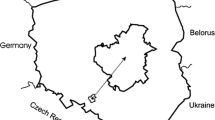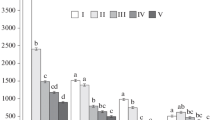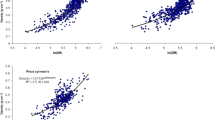Summary
Number, volume and size of snags, broken and uprooted trees as well as advancement of their decomposition and arrangement were analysed in a subalpine spruce forest in the Babia Góra massif (West Carpathians). The most important results are:
-
1.
The amount of coarse woody debris noted on Babia Góra was among the highest in subalpine spruce forests, however it was lower than in unmanaged boreal spruce forests, and much lower than in the mountain and boreal forests of North America.
-
2.
Most trees died standing, whereas uprooting was the rarest cause of mortality. The probability that a tree would die standing was greatest among thinnest and thickest individuals. The greater the diameter of spruce the higher was the probability of breakage. Uprooting was most common among trees of moderate diameter.
-
3.
Snags and broken stems were randomly distributed, whereas windthrows were clumped.
-
4.
Decomposition of spruce logs was a very slow process as these logs remain visible on the soil surface for about 150 years after tree death. The process is slower than in central Sweden, but much quicker than in boreal forests of northern Sweden.
-
5.
The diameter of dead trees and the spatial pattern of stand breakdown changed in recent years as a result of stand development and changes of causal factors.
-
6.
In recent years intensity of stand breakdown was nearly two times higher than stand growth when the volume of the trees was taken into account. This indicates the probability of the stand to enter the breakdown stadium.
Zusammenfassung
In einem subalpinen Fichtenwald des Babia Góra-Massivs (West-Karpaten) wurden Anzahl, Volumen und Größe von stehenden, gebrochenen und entwurzelten Totholzstämmen nebst ihrem Zersetzungsgrad und ihrer räumlichen Anordnung analysiert. Die wichtigsten Ergebnisse waren:
-
1.
Die am Babia Góra gefundene Totholzmenge gehört zu den höchsten, die bislang in subalpinen Fichtenwäldern des temperierten Europa festgestellt wurde, jedoch war sie geringer als in unbewirtschafteten borealen Fichtenwäldern und viel geringer als in Nadelwäldern der Gebirge und der borealen Zone Nordamerikas.
-
2.
Die meisten Bäume waren stehend abgestorben, während Windwurf die seltenste Mortalitätsursache war. Die Wahrscheinlichkeit des Absterbens war am höchsten unter den Individuen der geringsten und der stärksten Durchmesserklassen. Die Wahrscheinlichkeit von Stammbrüchen nahm mit steigendem Durchmesser zu. Windwurf war unter den Bäumen mittleren Durchmessers am häufigsten.
-
3.
Stehendes und gebrochenes Totholz war zufällig verteilt, während Windwürfe räumlich aggregierty auftraten.
-
4.
Die Zersetzung von Fichtenstämmen vollzieht sich sehr langsam, wie noch nach ca. 150 Jahren nach Absterben erkennbare Reste belegen. Der Prozess verläuft langsamer als in Zentralschweden, jedoch viel schneller als in borealen Wäldern Nordschwedens.
-
5.
Die Durchmesserverteilung des Totholzes und das räumliche Muster der Bestandeszusammenbrüche unterlag in den letzten 20 Jahren Veränderungen, die durch die Bestandesentwicklung und eine geänderte Häufigkeit der einzelnen Mortalitätsurachen bedingt war.
-
6.
In den letzten Jahren war das Volumen absterbender Bäume nahezu doppelt so hoch wie der Zuwachs der verbleibenden Bestandesglieder.
Similar content being viewed by others
7 References
Adamczyk, B., 1989: Characteristics of soils of selected areas in the upper spruce forest zone of Mt. Babia Góra. [In:]Korpel’, Š. (ed.), Stav, vývoj, produkcné schopnosti a funkcné vyuzivanie lesov v oblasti Babej Hory a Pilska. Lesnicka fakulta Vysokej Školy lesníckej a drevarskej Zvolen, Wydział Leśny Akademii Roln. Poznań, Wydział Leśny Akademii Roln. Kraków: 70–77 (in Polish).
Agee, J. K., Smith, L., 1984: Subalpine tree reestablishment after fire in the Olympic Mountains, Washington. Ecology 65: 810–819.
Arthur, M. A., Fahey, T. J., 1990: Mass and nutrient content of decaying boles in an Engelmann spruce — subalpine fir forest, Rocky Mountain National Park, Colorado. Can. J. For. Res. 20: 730–737.
Bałazy, S., Wiśniewski, J., 1987: Functional aspects of communities of the mites (Acarina) in the feeding sites of cambio- and xylophagous insects. [In:] IVth Symposium on the Protection of Forest Ecosystems. The role of cambio- and xylophagous insects in forest ecosystems. Warsaw Agricultural University Press, p. 143–151.
Capecki, Z., 1994: Forest health condition regions in Western Carpathians. Prace IBL 781: 61–125 (in Polish with English summary).
Diggle, P. J., 1983: Statistical analysis of spatial point patterns. Academic Press, London, 148 p.
Dynesius, M., Jonnson, B. G., 1991. Dating uprooted trees: comparison and application of eight methods in a boreal forest. Can. J. For. Res. 21: 655–665.
Fahey, T. J., 1983: Nutrient dynamics of aboveground detritus in lodgepole pine ecosystems, southeastern Wyoming. Ecol. Monogr. 53: 51–72.
Faliński, J. B., 1978: Uprooted trees, their distribution and influence in the primeval forest biotope. Vegetatio 38: 175–183.
Graham, R. L., Cromack, K. Jr., 1982: Mass, nutrient content, and decay rate of dead boles in rain forests of Olympic National Park. Can. J. For. Res. 12: 511–521.
Grodzińska, K., Szarek, G., Godzik, B., 1990: Heavy metal deposition in Polish national parks — changes during ten years. Water Air Soil Pollut. 49: 409–419.
Grundner, F., Schwappach, A., 1952: Massentafeln zur Bestimmung des Holzgehaltes stehender Waldbäume und Waldbestände. Berlin, Hamburg, 216 p.
Harmon, M. E., Cromack, K., Jr.,Smith, B. G., 1987: Coarse woody debris in mixed-conifer forests, Sequoia National Park, California. Can. J. For. Res. 17: 1265–1272.
Harmon, M. E., Franklin, J. F., Swanson, F. J., Sollins, P., Gregory, S. V., Lattin, J. D., Anderson, N. H., Cline, S. P., Aumen, N. G., Sedell, J. R., Lienkamper, G. W., Cromack, K., Jr.,Cummins, J. W., 1986: Ėcology of coarse woody debris in temperate ecosystems. Adv. Ecol. Res. 15: 133–302.
Hofgaard, A., 1993a: Structure and regeneration patterns in a virginPicea abies forest in northern Sweden. J. Veg. Sci. 4: 601–608.
Hofgaard, A., 1993b: 50 years of change in a Swedish boreal old-growthPicea abies forest. J. Veg. Sci. 4: 773–782.
Holeksa, J., 1998: Breakdown of tree stand and spruce regeneration versus structure and dynamics of a Carpathian subalpine spruce forest. Monogr. Bot. 82: 1–209 (in Polish with English summary).
Holeksa, J. (in press): Canopy gaps in a carpathian spruce forest. Forstwissensch. Centralblatt.
Holeksa, J., Parusel, J. B., 1989. Snow cover in the forest zones of the Babia Góra massif (West Carpathians). Acta Biol. Mont. 9: 341–352.
Hörnberg, G., Ohlson, M., Zackrisson, O., 1997: Influence of bryophytes and microrelief conditions onPicea abies seed regeneration patterns in boreal old-growth swamp forests. Can. J. For. Res. 27: 1015–1023.
Hytteborn, H., Packham, J. R., 1987: Decay rate ofPicea abies logs and the storm gap theory: a reexamination of Sernander plot III, Fiby Urskog, central Sweden. Arboric. J. 11: 299–311.
Hytteborn, H., Liu, Q.-H., Vervijst, T., 1991: Natural disturbance and gap dynamics in a Swedish boreal spruce forest. [In:]Nakagoshi, N., Golley, F. B. (eds.), Coniferous forest ecology from an international perspective. SPB Academic Publ., the Hague, p. 93–108.
Jaworski, A., Karczmarski, J., 1989: Structure, composition and dynamics of the upper mountain zone spruce stands i Babia Góra National Park. [In:]Korpel’, Š. (ed.), Stav, vývoj, produkcné schopnosti a funkcné vyuzivanie lesov v oblasti Babej Hory a Pilska. Lesnicka fakulta Vysokej Školy lesníckej a drevarskej Zvolen, Wydział Leśny Akademii Roln. Poznań, Wydział Leśny Akademii Roln. Kraków, p. 122–148 (in Polish with English summary).
Jaworski, A., Karczmarski, J., 1995: Structure, dynamics, and production potential of spruce stands in the upper mountain forest zone of Babia Góra National Park. Acta Acta Agr. Silv., Ser. Silv. 33: 75–113 (in Polish with English summary).
Jonsson, B. G., 1990: Treefall disturbance — a factor structuring vegetation in boreal spruce forests. [In:]Krahulec F., Agnew A. D. Q., Agnew S., Willems J. H. (eds.), Spatial processes in plant communities, p. 89–98.
Jonsson, B. G., Dynesius, M., 1993: Uprooting in boreal spruce forests: long-term variation in disturbance rate. Can. J. For. Res. 23: 2383–2388.
Korpel’, Š., 1980: Development and structure of natural spruce forests in Slovakia in relation to antiavalanche protective function. Acta Fac. For. Zvolen 22: 9–38 (in Slovak with English summary).
Korpel’, Š., 1989: Struktur, Entwicklung, Regeneration, Produktions- und Funktionsfähigkeiter der natürlichen Fichtenwälder auf Babia Hora. [In:]Korpel’, Š. (ed.), Stav, vývoj, produkcné schopnosti a funkcné vyuzivanie lesov v oblasti Babej Hory a Pilska. Lesnicka fakulta Vysokej Školy lesníckej a drevarskej Zvolen, Wydział Leśny Akademii Roln. Poznań, Wydział Leśny Akademii Roln. Kraków, p. 78–121 (in Slovak with German summary).
Korpel’, Š., 1993: Dynamics of a natural spruce forest in the Western Tatras on the example of the state nature reserve Kotlový Zl’ab. Zbornik Prac o TANAP 33: 193–225 (in Slovak with English summary).
Lertzman, K. P., Krebs, C. J., 1991: Gap-phase structure of a subalpine old-growth forest. Can. J. For. Res. 21: 1730–1741.
Maser, C., Trappe, J. M., 1984: The seen and unseen world of the fallen tree. USDA, PNW-General Technical Report 164: 1–56.
Matlack, G. R., Gleeson, S. K., Good, R. E., 1993: Treefall in a mixed oak-pine coastal plain forest: immediate and historical causation. Ecology 74: 1559–1566.
Mayer, H., Schenker, S., Zukrigl, K., 1972: Der Urwaldrest Neuwald bei Lahnsattel. Centralblat für das Gesamte Forstwesen 89: 147–190.
Myczkowski, S., 1964: The structure and ecology of the spruce associationPiceetum tatricum at the upper limit of its distribution studied in the valleys Dolina Stawów Gąsienicowych and Pańszczyca in the Tatra National Park. Ochr. Przyr. 30: 51–105 (in Polish with English summary).
Obrębska-Starklowa, B., 1963: The climate of Babia Góra. [In:]Szafer, W. (ed.), The Babia Góra National Park. Polish Acad. Sci., Kraków, p. 41–62 (in Polish with English summary).
Peterson, C. J., Pickett, S. T. A., 1991: Treefall and resprouting following catastrophic windthrow in an old-growth hemlock-hardwoods forest. For. Ecol. Manage. 42: 205–217.
Peterson, C. J., Pickett, S. T. A., 1995: Forest reorganization: a case study in an old-growth forest catastrophic blowdown. Ecology 76: 763–774.
Reif, A., Przybilla, M., 1995: Zur Regeneration der Fichte(Picea abies) in den Hochlagen des Nationalparks Bayerischer Wald. Hoppea, Denkschr. Regebsb. Bot. Ges. 56: 467–514.
Roovers, L. M., Rebertus, A. J., 1993: Stand dynamics and conservation of an old-growth Engelmann spruce — subalpine fir forest in Colorado. Nat. Areas J. 13: 256–267.
Saniga, M., Sklenár, P., 1989: Struktur, Entwicklung, Produktions- und Regenerationsverhältnisse von Naturwäldern im Naturschutzgebiet Pilsko. [In:]Korpel’, Š. (ed.), Stav, vývoj, produkcné schopnosti a funkcné vyuzivanie lesov v oblasti Babej Hory a Pilska. Lesnicka fakulta Vysokej Školy lesníckej a drevarskej Zvolen, Wydział Leśny Akademii Roln. Poznań, Wydział Leśny Akademii Roln. Kraków, p. 28–49 (in Slovak with English summary).
Schaetzl, R. J., Burns, S. F., Johnson, D. L., Small, T. W., 1989: Tree uprooting: review of impacts on forest ecology. Vegetatio 79: 165–176.
Schmidt-Vogt, H., Wütherich, G., Deichner, P., 1987: Untersuchungen zur Sturmstabilität von Fichten und Tannen in Fichten-Tannen-Mischbeständen auf verschiedenen Standorten Süddeutschlands. Allg. Forst u. Jagdztg. 158: 42–50.
Stewart, G. H., 1989: The dynamics of old-growthPseudotsuga forests in the Cascade Range, Oregon, USA. Vegetatio 82: 79–94.
Szwagrzyk, J., Ptak, J., 1991: Analyses of spatial structure of populations and communities based on mapped point patterns of individuals. Wiad. Ekol. 37: 107–124 (in Polish with English summary).
Ulanova, N. G., 1991: Vegetation mapping as a tool for detection of windfall processes in primary forest communities. Phytocoenosis 3 (N.S.), Suppl. Cartogr. Geobot. 2: 219–222.
Väisänen, R., Biström, O., Heliövaara, K., 1993: Sub-cortical Coleoptera in dead pines and spruces: is primeval species composition maintained in managed forests? Biodiv. Conserv. 2: 95–113.
Webb, S. L., 1988: Windstorm damage and microsite colonization in two Minnesota forests. Can. J. For. Res. 18: 1186–1195.
Wesołowski, T., Tomiałojć, L., 1986: The breeding ecology of woodpeckers in a temperate primaeval forest — preliminary data. Acta Orn. 22: 1–20.
Zientarski, J., 1976: Einfluss von Hoehenlage auf die Stammzahl und Entwicklung der Fichtenwalder des oberen Guertels im Babia Góra Nationalpark. Pozn. Tow. Przyj. Nauk, Prace Kom. Nauk Roln. i Kom. Nauk Leśn. 42: 137–149 (in Polish with German summary).
Author information
Authors and Affiliations
Corresponding author
Rights and permissions
About this article
Cite this article
Holeksa, J. Coarse woody debris in a Carpathian subalpine spruce forest. Forstw Cbl 120, 256–270 (2001). https://doi.org/10.1007/BF02796097
Published:
Issue Date:
DOI: https://doi.org/10.1007/BF02796097




